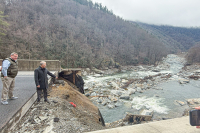Partial reopening at Haywood hospital
 Haywood Regional Medical Center is on its way to recovery after a small fire in its power room earlier this month knocked out the electrical system, closing the hospital and causing its 62 patients to be shuttled to hospitals in neighboring counties.
Haywood Regional Medical Center is on its way to recovery after a small fire in its power room earlier this month knocked out the electrical system, closing the hospital and causing its 62 patients to be shuttled to hospitals in neighboring counties.
As of Monday, the hospital’s emergency department, outpatient services and many of its supporting offices are open, slightly ahead of its original early July goal. Meanwhile, discussions with the insurance company mean that employees won’t have to skip paychecks or benefits while inpatient facilities remain closed.
“We are very pleased with how the recovery process has proceeded and we look forward to reopening all services in our main hospital very shortly,” said Janie Sinacore-Jaberg, HRMC’s president and CEO.
In order to open back up, the Emergency Department had to have functional redundant power, meaning that it have both a main source of power and a secondary one that would kick on immediately in the case of an outage. This ensures that patients undergoing treatment that depends on electrically-powered supports wouldn’t be harmed due to an outage.
Once HRMC determined it had its double power source up and running, the hospital completed its own technical review and then called the N.C. Department of Health Service Regulation in to inspect and authorize the partial re-opening. That inspection included numerous tests over a 24-hour period.
“It’s perfectly, 100 percent safe and we’ve been inspected to run these outpatient services off these two generators,” said Christina Deidesheimer, the hospital’s marketing and strategy director.
Related Items
The hospital can’t yet open its inpatient facilities, though, because treating inpatients requires that one energy source is non-generator, i.e., Duke Energy. Once a new transfer switch is installed, HRMC will be able to start the inspection process for a complete re-open, slated for mid- to late July.
Carolinas MED-1, the emergency response team that set up shop with a mobile emergency room in the hospital parking lot, will stay on site for a short while following the emergency department’s reopening, just in case any issues arise with the transition.
“This is another measure we’re taking out of an abundance of caution,” Deidesheimer said. “We’re in our facility and we’re clear to do so and we’re so excited to be back in our emergency department.”
The hospital closure marked the first time that MED-1, a mobile hospital owned by Carolinas HealthCare System, had responded to an event at one of the hospitals in its own system.
Moving on with the buyout
HRMC determined last week that its insurance policy would allow it to continue paying its employees the salaries and benefits they would have received had the hospital been open, but it’s still working through how the damages, consultation and inspection expenses and lost revenue from the closure will affect its bottom line.
“We have excellent insurance, and that’s all we know at this point,” Sinacore-Jaberg said.
At the time the fire and subsequent closure hit, the hospital was in the final stages of a buyout from Duke LifePoint Healthcare, based in Brentwood, Tenn. Initially, Duke LifePoint’s purchase of the Haywood hospital and WestCare in Sylva and Bryson City was slated to be official by late March, but that timeline had since been moved to call for a late July or early August closure. Now, it’s looking like the timeframe will get pushed back a little further — though because of some paperwork issues, not because of the fire and closure, Sinacore-Jaberg said.
When the deal closes, Haywood County will receive the buying price of $26 million, less any outstanding debts or expenses. Before the fire, that had been expected to work out to $8 million or so. Depending on what portion of the fire-related loss insurance covers, that number could go down.
Regardless, Duke LifePoint intends to go ahead with the acquisition.
“They said this didn’t make them nervous about the partnership,” Dr. Henry Nathan, a gastroenterologist at the hospital, said at the June 26 board meeting. “It made them feel even better, it made them feel so impressed about who they were going to be working with.”
Until the hospital is fully up and running, though, it’s all hands on deck. Hospital administrators and responders from Carolinas MED-1 have been working around the clock since the fire happened, and the neighboring hospitals that are accepting Haywood’s inpatients in the meantime have also stepped up to the plate. At Med-West Harris in Sylva, which accepted about 30 of the 62 evacuated patients, 70 of the hospital’s 86 beds were full when the hospital was first evacuated. That’s upwards of 80 percent occupancy, far above Harris’ average census of 50-some. But Harris procured emergency credentials for Haywood doctors and went on treating patients.
“Without WestCare and that medical staff and that team, we would not be nearly as successful, and we are successful,” Sinacore-Jaberg said.
But the ordeal isn’t over, and until the hospital is fully reopened and patient services completely restored, there will still be plenty of work to do.
“Were running full-bore,” Mike McKnight, the hospital’s chief financial officer, said ahead of the partial reopening. “We have everyone on it that we can run to test it and make sure it is safe for patients to come back.”
Inside Carolinas MED-1
The Carolinas MED-1 crew isn’t your standard medical team. They’re a crew of folks, mostly part-time, who deploy to give needed medical care in emergency situations, with crises ranging from the hospital fire at Haywood Regional Medical Center to the aftermath of Hurricane Katrina in 2005. The seven-vehicle unit contains all the medical equipment and staff accommodations necessary to offer a range of medical services, even in the absence of water and electricity.
“We have to be completely self-sufficient,” said Sarah Walsh, a paramedic on the team.
The unit carries enough to supply a 72-hour period, and a military-grade water purifier means that MED-1 has drinkable water anywhere H2O can be found. Supporting vehicles carry medical supplies, tools and showers, living space and bunks for the crew. It’s a converted NASCAR trailer, though, that houses the emergency room.
Inside, responders have a 12-bed capacity, including a dental chair, two operating room suites and four intensive care unit beds. They can do X-rays, and up to six patients can be on ventilators. And, if necessary, they can set up the tent and folded-up beds in the roof compartment to transform the trailer into a 150-bed hospital.
“We can be up and running with the hospital in right around four, four-and-a-half hours,” said MED-1 nurse Jim Slone, adding that the tent would take a while longer to set up.
Response time can indeed be quick. Within 18 hours of getting a call from hospital president and CEO Janie Sinacore-Jaberg, the Charlotte-based unit had a team assembled, the unit deployed and the hospital set up and accepting patients in Haywood County.
“We had some really serious cases,” Sinacore-Jaberg said. “That’s all we can say from a confidentiality standpoint, and we saved them.”









